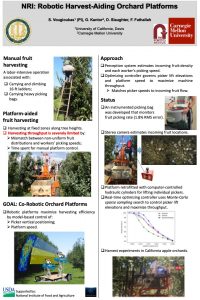In fresh market fruit production, harvesting is one of the most labor-intensive operations incurring high cost and dependence on a large seasonal semi-skilled workforce, which is becoming less available. With an eye toward mechanization, growers are increasingly adopting high-density orchards that feature narrow almost two-dimensional canopies that create “fruiting walls”, which are easier to harvest. Harvest-aid platforms are also being developed and offered by several companies as an intermediate step towards full mechanization. These machines aim at increased harvest efficiency by eliminating ladders. However, adoption by US growers is still limited, even in modern high-density orchards. The main reasons are high cost and often inadequate efficiency and labor savings. The major factor that limits harvesting throughput is the mismatch between the non-uniform fruit distribution and the pickers’ uneven and varying picking speeds.
This project aspires to develop affordable technologies for next-generation, robotic harvest-aid orchard platforms. The machines we envision will function as co-bots that collaborate with fruit pickers by physically carrying them and intelligently adjusting their vertical positioning with respect to the canopies in the orchard. The proposed machines will use advanced sensing to estimate incoming fruit yield and worker picking speeds. Based on these data they will modulate the incoming fruit flow by optimally adjusting their own travel speed, and dynamically elevate each picker to a ‘fruit zone’ that matches her/his speed and maximizes the overall platform throughput. Improved picker safety and ergonomics will also be incorporated in robotic platform design and operation.
Intellectual merit. The project investigates a novel human-robot physical interaction mode, in which a team of humans harvests fruit while standing on a robotic orchard platform, which controls each worker’s vertical positioning to optimize collective performance. A rigorous approach to automated harvest-aid platform operation analysis and control is proposed. The platform, workers, and the fruiting-wall system is regarded as a processing line in a flexible manufacturing system. The optimizing principle of matching incoming flow with machine capacity is applied to robotic platforms leading to the original concept of controlling platform speed and picker placement to match picker speeds with appropriate harvesting zones of the fruiting wall. The theoretical activities will be complemented with the advancement of state-of-the-art in imaging and sensing technologies to estimate fruit densities and picker harvest rates. If robotic picking is to become practical multi-arm robotic harvesters will face the same efficiency, sensing, and control issues. Therefore, by addressing robotic platform operation researchers are “paving the way” to fully mechanized selective harvesting.
Broader impact. By accelerating the adoption of robotic harvest-aid platforms the project will bring financial benefits for U.S. fruit growers; market advantages for SMEs building agricultural equipment; increased safety and higher wages for farmworkers; work opportunities for a wider, less physically capable labor pool, including women who are the backbone of rural communities; and fresh affordable fruits for consumers. The project’s educational agenda spans the graduate, undergraduate, and K-12 levels and utilizes project-based learning and fieldwork to cross-pollinate among disciplines. The researchers will leverage the themes of the project and the increasing awareness and concern for sustainable and healthy food production to engage K-12 students in STEM-promoting activities.






